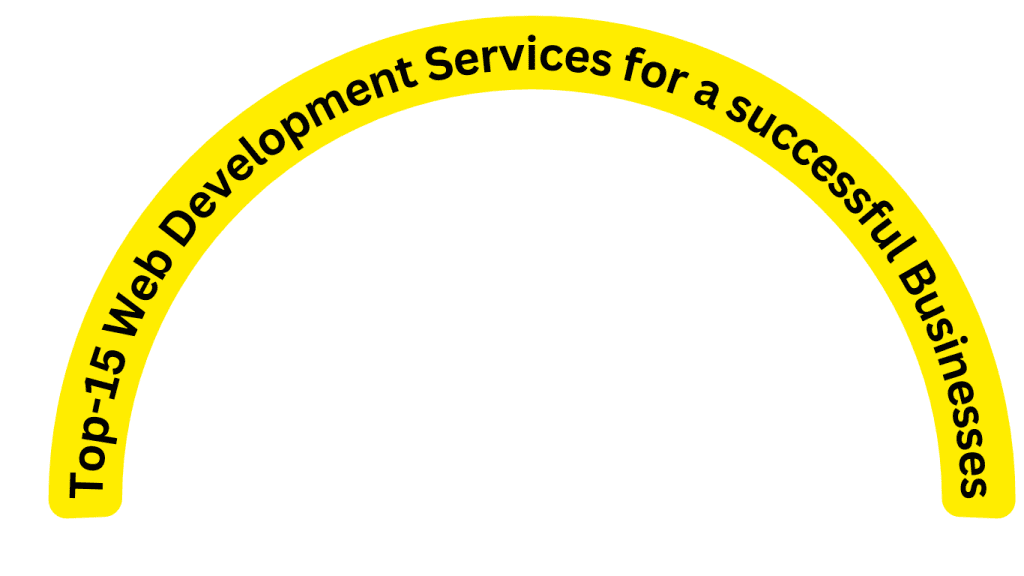Table of Contents
1. Introduction to Web Development Services
Web development services play a crucial role in today’s digital landscape, as businesses strive to establish a strong online presence. These services encompass various aspects of creating and maintaining websites, ensuring their functionality, user experience, and overall performance. From building custom web solutions to optimizing websites for search engines, web development services cover a wide range of functionalities that help businesses succeed in the competitive online market.
2. Custom Development

Custom development is the process of designing and building a website from scratch, tailored to the specific needs and requirements of a business or organization. It involves creating unique features, functionality, and design elements that are not available in pre-built templates or themes.
To get started with custom development, you will need to consider the following steps:
1. Planning and Requirement Gathering: Understand the goals, objectives, and target audience of the website. Discuss the specific features, functionalities, and design elements required.
2. Design: Create wireframes and prototypes to visualize the website’s layout, structure, and user interface. Pay attention to branding and user experience (UX) design.
3. Development: Write clean, efficient, and scalable code using appropriate development languages and frameworks such as HTML, CSS, JavaScript, and PHP. Implement the desired features and functionalities.
4. Content Creation: Develop or gather content such as text, images, videos, and other media to populate the website. Ensure that the content is relevant, engaging, and SEO-friendly.
5. Testing and Quality Assurance: Thoroughly test the website across different devices, browsers, and operating systems to ensure it functions correctly and provides a seamless user experience. Fix any bugs or issues identified during testing.
6. Maintenance and Updates: Regularly monitor and maintain to keep it up-to-date, secure, and functioning properly. Make necessary updates and improvements as needed.
3. Responsive Design


Responsive design is an approach to building websites that ensures the optimal viewing experience across a wide range of devices and screen sizes. With responsive design, a website can automatically adjust its layout, content, and design elements to fit different screen sizes, from desktop computers to tablets and smartphones.
To create a responsive design, consider the following principles:
1. Fluid Grids: Instead of using fixed pixel values, use fluid grids that distribute content proportionally across different screen sizes. This allows elements to resize and rearrange themselves as the screen size changes.
2. Flexible Images: Use CSS techniques, such as max-width: 100%, to ensure that images scale proportionally to fit different screen sizes without causing them to overflow or distort.
3. Media Queries: Apply media queries to define different sets of CSS rules for different screen sizes. This allows you to target specific styles to be applied at certain breakpoints or screen widths.
4. Breakpoints: Determine the breakpoints at which your design will switch layouts or apply different styling. Common breakpoints include small screens (e.g., smartphones), medium screens (e.g., tablets), and large screens (e.g., desktops).
5. Mobile-First Approach: Start designing and developing with the mobile screen size in mind first, then progressively enhance and add more complex features for larger screens.
6. Testing: Regularly test your website on different devices and browser sizes to ensure that it displays correctly and offers a seamless user experience across all platforms.
7. Performance Optimization: Optimize the performance of your responsive website by minimizing the file sizes of images and other assets, reducing unnecessary scripts and plugins, and optimizing code for faster loading times.
4. Ecommerce Website Development
Ecommerce development focuses on building robust online stores that enable businesses to sell products or services online. It involves implementing secure payment gateways, intuitive product catalogs, shopping carts, and other essential features to create a seamless buying experience for customers. Ecommerce are designed to maximize conversions, enhance customer trust, and streamline the overall online selling process.
5. Mobile App Development


With the ever-increasing popularity of smartphones, mobile app development has become a crucial aspect of web development services. A mobile app allows businesses to extend their digital footprint, engage with users on a more personal level, and offer enhanced functionalities compared to mobile-optimized. Mobile app development involves designing, coding, and testing applications for various mobile platforms like iOS and Android to ensure optimal performance and user satisfaction.
6. PHP Development
PHP development is a widely used scripting language for creating dynamic and interactive websites. It offers immense flexibility and supports integration with databases, making it ideal for building feature-rich applications. PHP developers utilize frameworks like Laravel or CodeIgniter to streamline the development process, improve security, and maintain code efficiency.
7. WordPress Website Development
WordPress website development refers to the process of designing and building a website using the WordPress content management system (CMS). WordPress a popular platform that allows users to create manage websites without extensive coding knowledge or experience.
Here are the key steps involved in WordPress development:
1. Planning: Identify the goals and objectives of your website. Consider your target audience, desired features, and functionality.
2. Domain and Hosting: Choose a domain name and select a hosting provider that supports WordPress.
3. Installation: Install WordPress on your hosting server. Most hosting providers offer easy, one-click WordPress installations.
4. Theme Selection: Choose a WordPress theme that suits your design preferences and requirements. You can find free and premium themes from the official WordPress theme repository or third-party theme marketplaces.
5. Customization: Customize your theme by modifying its layout, colors, fonts, and other visual elements. Some WordPress themes come with built-in customization options, while others may require using additional plugins or coding changes.
6. Content Creation: Create and publish high-quality content for your website’s pages, such as Home, About, Services, Blog, and Contact. Use the WordPress editor to format and organize your content.
7. Plugins: Enhance your website’s functionality by installing and configuring WordPress plugins. Plugins extend the default features of WordPress and allow you to add features like contact forms, SEO optimization, analytics, security, and more.
8. Responsiveness and Design Optimization: Ensure your website is mobile-friendly and responsive by testing it on different devices and screen sizes. Optimize your performance by optimizing image sizes, minimizing code, and utilizing caching plugins.
9. Testing and Quality Assurance: Thoroughly test your website to ensure all the functionality works correctly. Check for broken links, page load speed, and compatibility across different browsers.
10. Launch: Once you are satisfied with the design, functionality, and content of your website, it’s time to launch it. Make sure to double-check all the URLs, forms, and contact information before going live.
11. Maintenance and Updates: Regularly update WordPress core, themes, and plugins to maintain security and performance. Also, keep your content updated and frequently back up .
8. Frontend Development
Frontend development refers to the process of creating the user-facing components of a website or web application. It involves building the interface and functionality that users interact with directly in their browsers.
Here are some key aspects of frontend development:
1. HTML: Frontend developers use HTML (Hypertext Markup Language) to structure web content and define the elements on a webpage, such as headings, paragraphs, images, and forms.
2. CSS: Cascading Style Sheets (CSS) are used to define the visual appearance and layout of a webpage. Frontend developers use CSS to customize colors, fonts, spacing, and positioning of elements on the page.
3. JavaScript: Frontend developers use JavaScript to add interactivity and dynamic functionality to a webpage. JavaScript allows for actions like form validation, animations, and real-time updates without refreshing the page.
4. Frontend Frameworks: Frameworks like React.js, Angular, or Vue.js provide tools and libraries that simplify frontend development. They enable developers to build complex and interactive web applications more efficiently.
5. Responsive Design: Frontend developers ensure that websites are responsive and adapt to different screen sizes and devices. This includes using techniques like media queries and flexible layouts to create a consistent user experience across various devices.
6. Cross-browser Compatibility: Frontend developers ensure that websites are compatible with different web browsers (such as Chrome, Firefox, Safari, and Edge) to ensure consistent functionality and appearance.
7. Accessibility: Frontend developers strive to make websites accessible to all users, including those with disabilities. This involves following accessibility guidelines and implementing features like alternative text for images, keyboard navigation, and proper semantic HTML markup.
8. Performance Optimization: Frontend developers optimize the performance of websites by minimizing file sizes, optimizing images, reducing render-blocking resources, and implementing caching techniques.
9. Collaboration: Frontend developers often work closely with designers, backend developers, and other stakeholders to understand requirements, collaborate on UI/UX design, and ensure seamless integration between the frontend and backend layers.
9. Backend Development
Backend development refers to the process of creating and maintaining the server-side components, infrastructure, and logic of a web application. It focuses on the behind-the-scenes functionality that powers the user-facing frontend of a website.
Here are some key aspects of backend development:
1. Server-Side Programming: Backend developers use programming languages such as Python, PHP, Ruby, Java, or Node.js to write code that runs on the server and handles data processing, business logic, and database operations.
2. Database Management: Managing and interacting with databases is a crucial part of backend development. This involves designing the database schema, writing queries, and ensuring data integrity and performance.
3. API Development: Backend developers often create Application Programming Interfaces (APIs) that allow different systems or applications to communicate and exchange data. APIs enable integration with external services or mobile apps and provide data to frontend interfaces.
4. Security and Authentication: Implementing security measures to protect the application and user data is an important aspect of backend development. This includes implementing authentication and authorization mechanisms, encrypting sensitive data, and protecting against common security vulnerabilities.
5. Performance Optimization: Optimizing the backend code, database queries, and server configurations to enhance the application’s performance and scalability. This may involve techniques like caching, query optimization, and load balancing.
6. Middleware and Services: Incorporating middleware and third-party services into the backend architecture can enhance the functionality and efficiency of the application. Examples include integrating payment gateways, email services, cloud storage, or push notifications.
10. Programming


Programming refers to the process of writing code and creating applications that are specifically designed to be used on the web. It involves the development, Applications, and other digital solutions that can be accessed and used through internet browsers.
Programming typically involves languages such as HTML (Hypertext Markup Language), CSS (Cascading Style Sheets), and JavaScript, which are used to create the structure, layout, and interactivity of pages. Additionally, server-side programming languages like PHP, Python,, or Node.js are used to process user requests, retrieve data from databases, and perform various server-side tasks.
1. Front-End Development: Concerned with creating the user interface and user experience of a website application using HTML, CSS, and JavaScript. Front-end frameworks and libraries like React, Vue.js, or AngularJS can be used to enhance development efficiency.
2. Back-End Development: Handles the server-side implementation of applications, which includes server configuration, database management, and handling user requests. Common back-end languages/frameworks include PHP, Java, .NET, Django, Ruby on Rails, and Express.js.
3. Databases: Applications often require storage and retrieval of data. Common database systems used in development include MySQL, PostgreSQL, MongoDB, and SQLite.
4. APIs (Application Programming Interfaces): APIs allow applications to communicate with each other. They enable data exchange and functionality integration between different systems, such as payment gateways, social media platforms, or third-party services.
5. Security: Programming involves implementing security measures to protect user data and prevent unauthorized access. This includes practices like encryption, secure authentication, input validation, and protection against common vulnerabilities such as Cross-Site Scripting (XSS) or SQL injection.
6. Testing and Debugging: Thorough testing and debugging are essential to ensure the functionality and quality of web applications. Tools like Chrome DevTools, automated testing frameworks, and code analysis tools can help with this process.
7. Version Control: Collaborative programming often relies on version control systems such as Git. These tools enable multiple developers to work on the same codebase, track changes, and manage code revisions.
11. Website Maintenance Services
Maintenance services are crucial for the proper functioning and longevity of a website. These services involve regular monitoring, updates, backups, and bug fixes to ensure optimal performance, security, and user experience. By regularly maintaining, businesses can prevent downtime, improve loading speeds, address security vulnerabilities, and provide a seamless experience for visitors.
12. Website Redesign
Redesign services focus on revamping existing websites to align them with current trends, improve user experience, or update the overall visual appeal. It involves refreshing layouts, implementing new design elements, optimizing navigation, and enhancing overall functionality. Redesign services aim to keep websites modern, intuitive, and relevant to meet evolving user expectations and maintain a competitive edge.
13. CMS Development
CMS development refers to the process of creating and customizing Content Management Systems (CMS). A CMS is a software application that allows users to create, manage, and organize digital content on websites without requiring extensive technical knowledge or coding skills.
Here are some key aspects of CMS development:
1. Selection of CMS: Choose an appropriate CMS platform based on your specific requirements and preferences. Popular CMS options include WordPress, Joomla, Drupal, Shopify, and Magento.
2. Installation and Configuration: Set up the CMS on a web server environment and configure the necessary settings. This involves creating databases, configuring user permissions, and customizing basic settings.
3. Theme/Template Development: Design and develop custom themes/templates or select pre-designed ones that align with your website’s branding and layout requirements. Themes/templates control the visual appearance and layout.
4. Plugin/Module Development: Extend the functionality of the CMS by developing or installing plugins/modules. Plugins/modules add extra features and capabilities to the CMS, such as contact forms, social media integrations, e-commerce functionality, or SEO tools.
5. Content Creation and Management: Utilize the CMS interface to create, edit, and organize content. The CMS offers user-friendly content editors, allowing you to add text, images, videos, and other media to pages or blog posts.
6. Customization: Customize the CMS’s features, settings, and workflows based on your specific needs. This may involve modifying existing code, implementing custom functionalities, or integrating third-party services.
7. Security: Implement security measures to protect the website and its content from unauthorized access and malicious attacks. This includes keeping the CMS and its plugins/modules up to date, using secure authentication methods, and following security best practices.
14. SEO Optimization
SEO optimization refers to the practice of optimizing a website in order to improve its visibility and ranking on search engine results pages (SERPs). SEO stands for Search Engine Optimization and involves various strategies and techniques aimed at attracting organic (non-paid) traffic.
Here are some key aspects of SEO optimization:
1. Keyword Research: Identify relevant keywords and phrases that users are likely to search when looking for information related to your business.
2. On-Page Optimization: Optimize individual web pages by incorporating target keywords into elements like page titles, headings, meta descriptions, URL structures, and content.
3. Content Creation: Create high-quality, informative, and engaging content that caters to the interests and needs of your target audience. Use keywords strategically throughout the content while ensuring it remains natural and valuable.
4. Technical Optimization: Optimize technical elements of your website, such as site speed, mobile-friendliness, crawlability, and indexing. Ensure proper HTML coding, use clean URLs, enable XML sitemaps, and implement structured data markup.
5. Link Building: Acquire high-quality backlinks from authoritative and relevant websites to improve your website’s authority and credibility. This can be done through guest blogging, outreach campaigns, social media promotion, and creating shareable content.
6. User Experience Optimization: Provide an intuitive and user-friendly website experience by optimizing navigation, site architecture, and usability. Ensure fast page loading times, responsive design, easy-to-read font sizes, and clear calls-to-action.
7. Local SEO: Optimize your website for local search results if you have a local business. This includes creating and optimizing a Google My Business listing, incorporating local keywords, and encouraging customer reviews.
15. Security
Security is of utmost importance in today’s digital landscape, where cyber threats are prevalent. Development services include implementing robust security measures to protect websites from unauthorized access, data breaches, malware attacks, and other potential vulnerabilities. This involves implementing SSL certificates, firewalls, regular security audits, and secure coding practices to ensure the safety of user data and maintain the trust of website visitors.
Powered by Bestwritebot.com , Otips , Free Video Downloader , softwarestore , free online game hub


